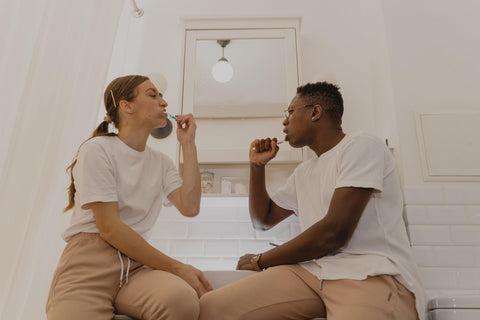Are Microplastics Harmful to Our Health?
You probably already know that our world has a major issue with plastic pollution. It’s in our oceans and on our land. But, believe it or not, it gets even worse than this. Microplastics are stealing headlines lately, and it’s because, in certain ways, they’re an even bigger threat.
What are we learning about microplastics? Well, Consumer Reports recently found that in the roughly 100 foods they tested, phthalates were present in almost all of them. (Phthalates are chemicals used to make plastic stronger.) Other research tells us that we eat at least 50,000 plastic particles a year. One 2019 analysis infamously said that the average human might be ingesting five grams of plastic per week — approximately the size of a credit card. (Imagine that: eating a credit card every week!)
Plastic, in various forms, is negatively impacting our water, food, and ultimately, our health. But how?
First, What are Microplastics, Anyway?
The National Ocean Service says that to count as a “microplastic,” the piece must be less than five millimeters long — roughly the size of a pencil eraser.
Microplastics can come from bigger pieces of plastic that eventually break down. However, they can also come straight from everyday products you might be using. For example, your body wash or toothpaste might include microplastics as an ingredient, meant to exfoliate your skin and better clean the surface of your teeth.

The Dangers of Microplastics in Water
Researchers have found microplastics in all types of water, including wastewater, fresh water, tap water, and bottled water. They come in different forms, too, such as physical particles, chemicals, and microbial pathogens. While research is ongoing, it seems that plastic might most commonly end up in our water thanks to terrestrial run-off and wastewater effluent (meaning wastewater and sewage that are released into bodies of water). We can even inhale microplastics.
In an ironic twist, plastic bottles and their caps are actually a source of microplastics in our drinking water — yet another reason to ditch bottles.
Are Microplastics Harmful to Humans?
Yes, research tells us that consuming microplastics can be dangerous to our health. Specifically, they can stimulate the release of endocrine disruptors. Endocrine disruptors (like phthalates) can mimic, stop, or interfere with your body’s hormones, which can lead to several scary health issues. For example, they might tell your body to produce more insulin when it’s not needed.
That’s not all. Additionally, microplastics can carry along other dangerous chemicals — like heavy metals and organic pollutants. While, in some cases, very small amounts of certain heavy metals are good for our health, too much can quickly lead to heavy metal poisoning.
Finally, research using rats and mice found that microplastics in their bodies could cause a significant and aggressive immune system response, ultimately damaging the organs of the body.
Can Our Bodies Get Rid of Them?
Microplastics are indeed setting up shop inside our bodies. Scientists have found them in our blood, breast milk, and placentas. “But don’t we just eliminate them when we use the bathroom?” you might be thinking, and that’s a fair question!
Yes, this can be the case for larger pieces of plastic. Maybe you’ve known of a child or pet who swallowed a tiny object and eventually passed it. However, that’s not necessarily how it works with microplastics, which are so small that your intestinal wall will absorb them.

Indeed, there’s a strong likelihood that after these tiny plastics make a new home in our bodies, they stay there permanently.
How to Eliminate Microplastics From Your Drinking Water
Maybe you have a strict diet of organic and non-GMO foods and beverages. But make no mistake about it: Even the healthiest, pickiest eater is still ingesting microplastics. You’re drinking them, too — even if you have a pitcher filter or a refrigerator filter. These filters simply don’t have the right designs and technology to remove such tiny contaminants from the water you drink.
So, it’s safe to assume that microplastics are still lurking in your tap water.
How to Remove Plastic From Your Water
Fortunately, there’s one type of water filtration technology that is capable of removing microplastics: reverse osmosis (RO). Reverse osmosis involves a semipermeable membrane that has very tiny holes in it. During this process, pressure forces the water through the membrane.
Due to the size of these holes (about 0.0001 microns in size), only water molecules can pass through, while everything else — like microplastics — is filtered out. There’s just not enough room for them to get by.
Tiny plastics aren’t the only thing RO will remove. It’ll also take the bacteria (E. coli, salmonella), viruses (hepatitis A, norovirus), contaminants (chromium, lead), and protozoa (which can cause diseases like malaria and giardia) out of your drinking water.
What you’re left with is tap water that tastes good and fresh, and it’s safe for you and your family to drink.
The Sans Water Purifier
Even if they use RO, not all water filters are created equally. So, what should you look for?
The Sans Water Purifier uses a four-layer reverse osmosis filter — plus UV-C light — to eliminate up to 99% of the contaminants in your water, including microplastics, heavy metals, chemicals, viruses, and bacteria. The proof is right in front of you: The water quality monitor gives you real-time insights into how pure your water is. It auto-dispenses into the removable glass pitcher and can also instantly provide hot water.
The replaceable filters last anywhere from 12 to 24 months, there’s a 30-day risk-free trial, and it comes with a three-year warranty so that Sans will back you should you need a repair or replacement. While you might not know what’s coming out of your tap, you can know what’s coming out of Sans.
We can’t survive without water, and we can’t thrive without clean, safe water. Learn more about the Sans Water Purifier today.